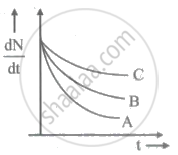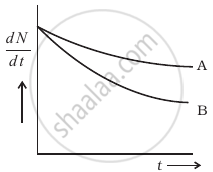Advertisements
Advertisements
प्रश्न
Define the term 'decay constant' of a radioactive sample. The rate of disintegration of a given radioactive nucleus is 10000 disintegrations/s and 5,000 disintegrations/s after 20 hr. and 30 hr. respectively from start. Calculate the half-life and the initial number of nuclei at t= 0.
उत्तर
The decay constant is the fraction of the number of atoms that decay in one second.
It is denoted by A.
Let N0 be the initial number of nuclei,
Let λ be the decay constant
Let t1/2 be the half-life
The instantaneous activity of radioactive material is given by `A = A_0e^(-lambdat)`
Where A0 is activity at t = 0
Therefore, after 20 hours is 10,000 disintegrations per second
`10,000 = A_0e^(-lambda(20 xx 3600))` ...(1)
Activity after 30 hours is 5,000 disintegrations per second
`5000 = A_0e^(-lambda(30 xx 3600))` ..(2)
On dividing (1) by (2),
`2 = e^(lambda xx 3600)`
⇒ `lambda = ln 2/36000 = 1.92 xx 10^-5`
And half life is,
`ln 2/(1.92 xx 10^-5) = 36,000"s" = 10` hours
Since,
`(dN)/(dt) = lambdaN`
`1000 = (1.92 xx 10^-5) xx N_1`
⇒ `N_1 = (10,000)/(1.92 xx 10^-5) = 5.208 xx 10^8`
Therefore, the half life is 10 hours, thus the initial number of nuclei is `N_0 = 10.416 xx 10^8`
APPEARS IN
संबंधित प्रश्न
Represent Radioactive Decay curve using relation `N = N_o e^(-lambdat)` graphically
Two different radioactive elements with half lives T1 and T2 have N1 and N2 undecayed atoms respectively present at a given instant. Derive an expression for the ratio of their activities at this instant in terms of N1 and N2 ?
Why is it experimentally found difficult to detect neutrinos in this process ?
Lithium (Z = 3) has two stable isotopes 6Li and 7Li. When neutrons are bombarded on lithium sample, electrons and α-particles are ejected. Write down the nuclear process taking place.
The decay constant of 238U is 4.9 × 10−18 S−1. (a) What is the average-life of 238U? (b) What is the half-life of 238U? (c) By what factor does the activity of a 238U sample decrease in 9 × 109 years?
57Co decays to 57Fe by β+- emission. The resulting 57Fe is in its excited state and comes to the ground state by emitting γ-rays. The half-life of β+- decay is 270 days and that of the γ-emissions is 10−8 s. A sample of 57Co gives 5.0 × 109 gamma rays per second. How much time will elapse before the emission rate of gamma rays drops to 2.5 × 109per second?
Obtain a relation between the half-life of a radioactive substance and decay constant (λ).
Before the year 1900 the activity per unit mass of atmospheric carbon due to the presence of 14C averaged about 0.255 Bq per gram of carbon.
(a) What fraction of carbon atoms were 14C?
(b) An archaeological specimen containing 500 mg of carbon, shows 174 decays in one hour. What is the age of the specimen, assuming that its activity per unit mass of carbon when the specimen died was equal to the average value of the air? The half-life of 14C is 5730 years.
Which one of the following nuclei has shorter meant life?

Which sample, A or B shown in figure has shorter mean-life?

